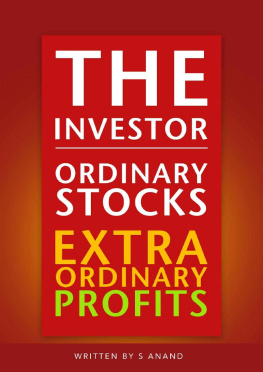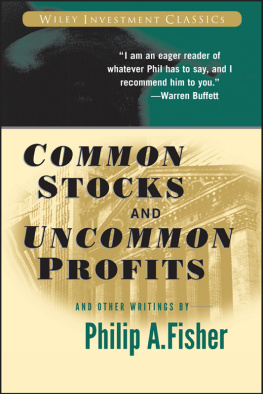Anand S - Ordinary Stocks Extra Ordinary Profits
Here you can read online Anand S - Ordinary Stocks Extra Ordinary Profits full text of the book (entire story) in english for free. Download pdf and epub, get meaning, cover and reviews about this ebook. year: 2014, genre: Business. Description of the work, (preface) as well as reviews are available. Best literature library LitArk.com created for fans of good reading and offers a wide selection of genres:
Romance novel
Science fiction
Adventure
Detective
Science
History
Home and family
Prose
Art
Politics
Computer
Non-fiction
Religion
Business
Children
Humor
Choose a favorite category and find really read worthwhile books. Enjoy immersion in the world of imagination, feel the emotions of the characters or learn something new for yourself, make an fascinating discovery.
Ordinary Stocks Extra Ordinary Profits: summary, description and annotation
We offer to read an annotation, description, summary or preface (depends on what the author of the book "Ordinary Stocks Extra Ordinary Profits" wrote himself). If you haven't found the necessary information about the book — write in the comments, we will try to find it.
Anand S: author's other books
Who wrote Ordinary Stocks Extra Ordinary Profits? Find out the surname, the name of the author of the book and a list of all author's works by series.
Ordinary Stocks Extra Ordinary Profits — read online for free the complete book (whole text) full work
Below is the text of the book, divided by pages. System saving the place of the last page read, allows you to conveniently read the book "Ordinary Stocks Extra Ordinary Profits" online for free, without having to search again every time where you left off. Put a bookmark, and you can go to the page where you finished reading at any time.
Font size:
Interval:
Bookmark:

Contents
Acknowledgements 4
Prologue
CHAPTER 1
Introduction
Types of Investors
Stock Exchanges and Indices
Depositories
Broker and his role
Bonus Issues
Rights Issues
Convertible Bonds
Split of Shares
Dividend
Comparison between two asset classes
Is this a good market?
CHAPTER 2
Business cycle 35
Role of Government in Economy
Open and Closed Economies
Effect of Interest rate on Economy and Stocks
Monetary Policy
Fiscal Policy
Interest Rate and Stock Markets
Effect of Inflation on stocks
What is meant by recession?
Regulators and their roles
CHAPTER 3
Equities
Moat
Fishers Test
Value Stocks
Growth Stocks
Turn around Stocks
Momentum Stocks
CHAPTER 4
Fundamental Analysis
Limitations of Fundamental Analysis
Intrinsic Value of a Company
Margin of Safety
Speculation and Investment
Classification of Investors
Rules of Investment in common stock for
a defensive investor
A note on Systematic Investment Plan (SIP)
Changes in ones portfolio
Defensive Investor and Growth Stocks
Buy what you Know Best
Why not 100% in Equities
Investing Plan for Enterprising Investor
Bargain issues in mid cap companies
The Investor and Wild Swings in the Market
The Mind of an Investor
CHAPTER 5
The Annual Report and the Investor 209
Balance Sheet Analysis
The Profit and Loss Statement
Cash Flow Statement
Notes to account and Auditors report
A note on equity fund in the Balance Sheet
Continuation of a company that is sick
Why Technical analysis does not work
CHAPTER 6
Ratios 271
Book Value
Asset values and Investment values
Intangibles and valuation
How to deal with deficit earnings
Price to earnings ratio or rate of capitalization
Price to sales ratio
Return on Invested capital
Dividend yields
Dividend Payout ratio
Post Script
ACKNOWLEDGEMENT
The idea that I write a book came from my friend Amal Muraly, who came to sell insurance to me and got attracted to the markets. The idea crystallized after a long discussion with a distant relative in a family wedding. The book was five years in the making as the market swung from one extreme to another. This led to the realization that the factors that determine the market are beyond the terminals of a broker or the floors of an exchange.
My debt of gratitude is to my parents P.S.Srinivasan and K.P.Kamakshi, who introduced me to the world of stocks at a very early age.
My friend Dileep, who stood alongside me as a rock of Gibraltar through times both good and bad and putting up with me patiently.
My friend Sundar, who forced my re-entry into the market in 2004 after a particularly difficult time, along with him I relearned the markets.
My friend Subba Krishna Rao, who took out time from his busy schedule to do the final editing of this book.
My wife Srividhya Swaminathan for patiently typing and deciphering my illegible long hand and constantly motivating me in all my endeavors.
My Sister-in-law Mrs.Mythili Kailasam for reading several manuscripts and suggesting changes and correcting errors that I overlooked.
My Brother Vinod Srinivasan for designing the cover and convincing me to publish this book.
My Nephew Sashwath Swaminathan, who grew up along with this book and the markets for putting up with my prolonged hours of absence from his playtime.
I have used theories developed by Graham, Fisher and Carret in the first half of this century.
I have adapted it to Indian markets with examples from Dalal Street.
The errors in this book that may have come from oversight must be solely attributed to me.
ANAND. S
13-05-2013
MADRAS.
Prologue
The seed of this book was germinating within me since 2008. With the help of one of my students, I put together an outline and left it there for three years. I began working on it again in the year 2012. This book has become completely different from what I imagined it originally.
My initiation into stocks was started by m other when I was Nineteen and during an enforced break from college. I started to read in those days. Due to strict foreign exchange control the relevant books on stocks and investments were not available. There were no computers or the Internet. India was a socialist state and profit was a bad word. When I finally came out of college, it was the year of change in 1991, when Dr Manmohan Singh swept the cobwebs out of our collective minds. The regime of allowing free import of books came about in 1996, by then the Harshad Mehta scam swept out any interest in stocks in the common public.
I discovered a few books and through them met people like George Soros, Warren Buffet and Peter Lynch.
The first book I read was in 1991, borrowed from an NRI chartered accountant who was reading Alchemy of Finance." I read that book and it went over my head completely. I read Peter Lynch's classic books on stock markets. They were One Up on Walls Street and Beating the Street armed with that knowledge I bought a portfolio of stocks. In the year 1996, I finally read Intelligent Investor and Security Analysis of Graham and Dodd.
In the mean time, m y other businesses were booming and I drifted away from active investing after the Asian Financial crisis. To add to this there was the Ketan Parekh scam and a severe recession in India around the year 1999-2002. The general recession and tight credit cycle and falling margins made me exit my main business. The pressures of shutting down and winding down a business exposed me to the harsh limitations of the Indian system. Once again in 2003, I started looking at the markets again. When I started nibbling at stocks and used the Internet to find new resources. I decided to dig further and re-read the entire library of books that I had collected and kept seeking for maximum information on the fundamentals of economics, the boom-bust theory, the importance of interest rates and Central Banks. The beginning of a major bull run in all asset classes started in 2004.
I revisited my old portfolio made nearly 10 years ago and was amazed with the results that I as an amateur following Peter Lynch, Warren Buffet and Ben Graham generated. In 2006, I decided to become a full time investor when I called the coming of the gold boom, which commenced in 2003 and I realized that we were in for a multiyear bull market.
I was sure of the coming collapse in 2008. This collapse was triggered by the public issue of Reliance Power. I had begun teaching investing to few a people. The principle of Graham, Buffet, Philp Fisher, Carret and Peter Lynch was reinforced. This was the time I stumbled upon two characters, which changed my line of thinking fundamentally, one was Fredrich Von Hayek and the other was a Seventeenth century investor called Richard Cantillon.
Cantillon, was the first of the great investors who made money both in the boom of the Mississippi bubble and doubled his position during the bust by shorting the market all the way down. Little is known about him and the only surviving manuscript is an essay he wrote on how markets are organized. This was long before Adam Smith. There is a scholarly biography written by a Scottish professor on Cantillon which one must definitely read.
I saw the collapse coming when the stock market recovered in 2009 on Government stimulus after the elections, though I did not profit from this fully.
Next pageFont size:
Interval:
Bookmark:
Similar books «Ordinary Stocks Extra Ordinary Profits»
Look at similar books to Ordinary Stocks Extra Ordinary Profits. We have selected literature similar in name and meaning in the hope of providing readers with more options to find new, interesting, not yet read works.
Discussion, reviews of the book Ordinary Stocks Extra Ordinary Profits and just readers' own opinions. Leave your comments, write what you think about the work, its meaning or the main characters. Specify what exactly you liked and what you didn't like, and why you think so.







